
|
|
|
|
|
|
Classic Bikes
Custom Bikes
Individual
Racing Bikes AJP
AJS
Aprilia
Ariel
Avinton / Wakan
Bajaj
Benelli
Beta
Bimota
BMW
Brough Superior
BRP Cam-Am
BSA
Buell / EBR
Bultaco
Cagiva
Campagna
CCM
CF Moto
Combat Motors
Derbi
Deus
Ducati
Excelsior
GASGAS
Ghezzi Brian
Gilera
GIMA
Harley Davidson
Hero
Highland
Honda
Horex
Husaberg
Husqvarna
Hyosung
Indian
Jawa
Kawasaki
KTM
KYMCO
Laverda
Lazareth
Magni
Maico
Mash
Matchless
Mondial
Moto Guzzi
Moto Morini
MV Agusta
MZ / MuZ
NCR
Norton
NSU
Paton
Peugeot
Piaggio
Revival Cycles
Roland Sands
Royal Enfield
Sachs
Sherco
Sunbeam
Suzuki
SWM
SYM
Triumph
TVS
Ural
Velocette
Vespa
Victory
Vincent
VOR
Voxan
Vyrus
Walt Siegl
Walz
Wrenchmonkees
Wunderlich
XTR / Radical
Yamaha
Zero
Video
Technical
Complete Manufacturer List
|
Honda CRF 1100L Africa Twin Adventure Sports ES / DCT |
| . |
|
Make Model |
Honda CRF 1100L Africa Twin Adventure Sports ES / DCT |
|
Year |
2021 |
| Engine | Four stroke, parallel Twin with 270° crank and Uni-cam, SOHC, 4 valves per cylinder |
|
Capacity |
1084 cc / 66.1 cu-in |
|
Bore x Stroke |
92.0 x 81.5 mm |
|
Compression Ratio |
10.1:1 |
| Cooling System | Liquid cooled |
|
Emission |
112g/km MT / 110g/km DCT |
| Induction | PGM-FI electronic fuel injection w/ 46mm throttle bodies (Throttle By Wire) |
| Ignition | Full transistorized ignition |
| Battery | 12V-6Ah Li-ion battery (20hr) |
| Starting | Electric |
|
Max Power |
75 kW / 100.5 hp @ 7500 rpm |
|
Max Torque |
105 Nm / 77.4 ft-lb @ 6250 rpm |
| Clutch |
Wet, multiplate with coil springs, aluminium cam assist and slipper clutch DCT – 2 wet multiplate clutches with coil springs |
|
Transmission |
Constant mesh 6-speed manual / 6-speed DCT with on- and off-road riding modes |
| Final Drive | 525 Chain |
| Frame | Steel semi-double cradle type with high-tensile strength steel rear sub-frame |
|
Front Suspension |
45mm cartridge-type inverted Showa telescopic fork with dial-style preload adjuster and damping adjustment w/ EERA |
|
Front Wheel Travel |
230 mm / 9.0 in |
|
Rear Suspension |
Monoblock aluminium swing arm with Pro-Link with Showa gas-charged damper, hydraulic dial-style preload adjuster and rebound damping adjustments w/ EERA |
|
Rear Wheel Travel |
220 mm / 8.6 in |
|
Front Brakes |
2x 310 mm wave floating hydraulic disc with aluminium hub and radial fit 4-piston calipers and sintered metal pads |
|
Rear Brakes |
Single 256mm wave hydraulic disc with single piston caliper and sintered metal pads. 2-Channel with rear ABS off mode |
|
ABS System |
2 channel with IMU, Selectable ABS MODE with on-road and off-road setting |
| Wheels | Wire spoke with aluminium rim |
| Front Wheel | 21M/C x MT2.15 |
| Rear Wheel | 18M/C x MT4.00 |
|
Front Tyre |
90/90-21M/C 54H (tubeless type) |
|
Rear Tyre |
150/70R18M/C 70H (tubeless type) |
| Rake | 27.5° |
| Trail | 113 mm / 4.4 in |
| Dimensions |
Length 2330 mm / 91.7 in Width 960 mm / 37.9 in Height 1560 mm / 61.5 in - 1620mm / 63.7 in with screen in uppermost position) |
| Wheelbase | 1575 mm / 62 in |
| Seat Height | 850 mm / 33.5 in - 870 mm / 34.2 in (low seat option 825 mm / 32.5 in, high seat option 895 mm / 35.2 in) |
| Ground Clearance | 250 mm / 9.8 in |
|
Wet Weight |
238 kg / 528.7 lbs - 248 kg / 546.7 lbs DCT With Showa EERA 240kg / 529.1 lbs MT (DCT 250 kg / 551.1 lbs) |
|
Fuel Capacity |
24.8 Litres / 6.5 US gal |
| . |
From a press release from Honda:
Comprising two distinct versions based on a versatile platform, Honda's Africa Twin embraces the “True Adventure” ethos, winning fans across a broad range of consumers. These adventure touring machines boast an aggressive appearance and capable performance, thanks to an enjoyable engine and capable chassis. Whereas the standard CRF1100L Africa Twin delivers sporting and off-road performance, the Adventure Sports ES boasts comfort and convenience for tackling long distances. Both versions are available with either a manual gearbox or Honda's advanced automatic Dual Clutch Transmission, and for 2021, both are offered in new colors.
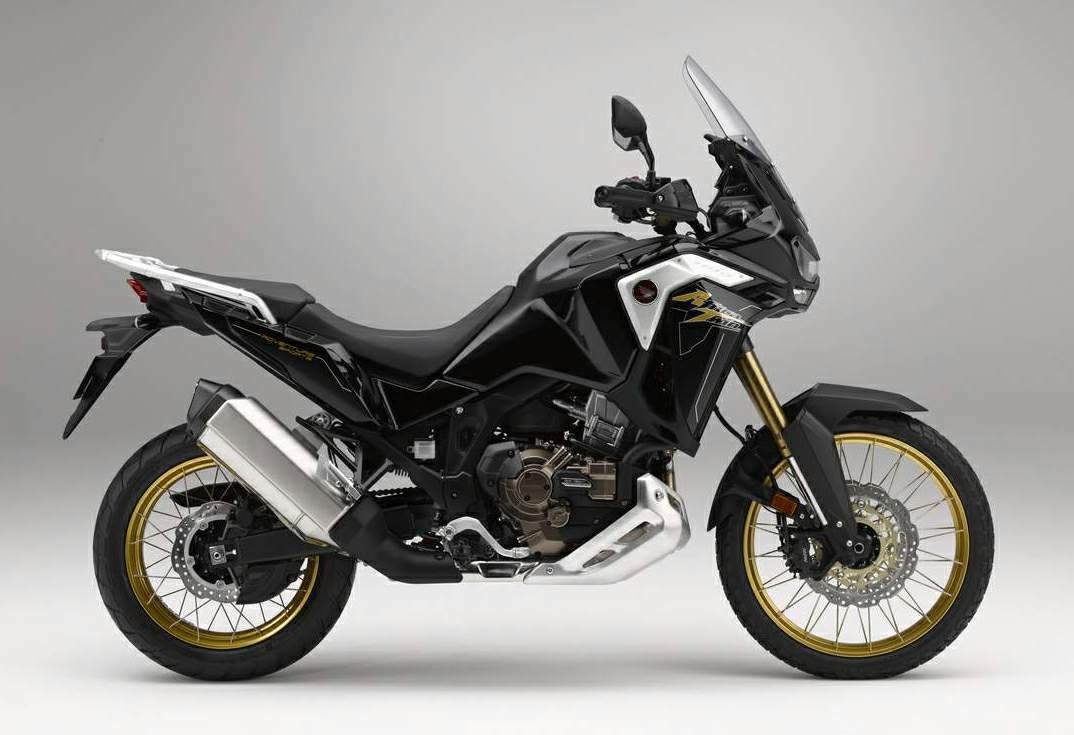
HISTORY
Since the 1988 introduction of the XRV650 in Europe, Honda's Africa Twin concept has come to represent the “True Adventure” ethos of ADV riding. That original version, based on the NXR750 and NXR800 factory racers that swept the Dakar Rally between 1986 and 1989, created a new market, grew into the XRV750 in 1990 and sold over 73,000 units before it was discontinued in 2001. The Africa Twin was reborn in 2016 with the CRF1000L, also offered in extra-European markets including the U.S. In 2019 the standard Africa Twin was joined by the more touring-focused Adventure Sports version, with improved wind protection, greater fuel capacity and longer-travel suspension. As was the case with the original, the modern Africa Twin has been a global hit with a wide array of adventure-riding enthusiasts, selling over 87,000 units worldwide. Now, 2020 is set to be a landmark model year for the Africa Twin.
DESIGN / STYLING
Staying true to the “True Adventure” concept, both Africa Twin types feature a high-mount front fairing, upright body position and 21- and 18-inch front and rear wheels, respectively, capably expressing the model's heritage.
The standard version features a slim, lightweight look, with compact lines that befit its off-road focus. Its minimalist, fixed windscreen eases front-rear bodyweight transfers during aggressive riding in rough terrain, while still minimizing wind buffeting on the chest at high speeds(An accessory high screen is available.) The fuel tank still holds 5.0 gallons, the tires and spoke wheels are still tube-type, and there's no rear rack, for a narrow rear. The standard Africa Twin is offered in a new Pearl White color for 2021.
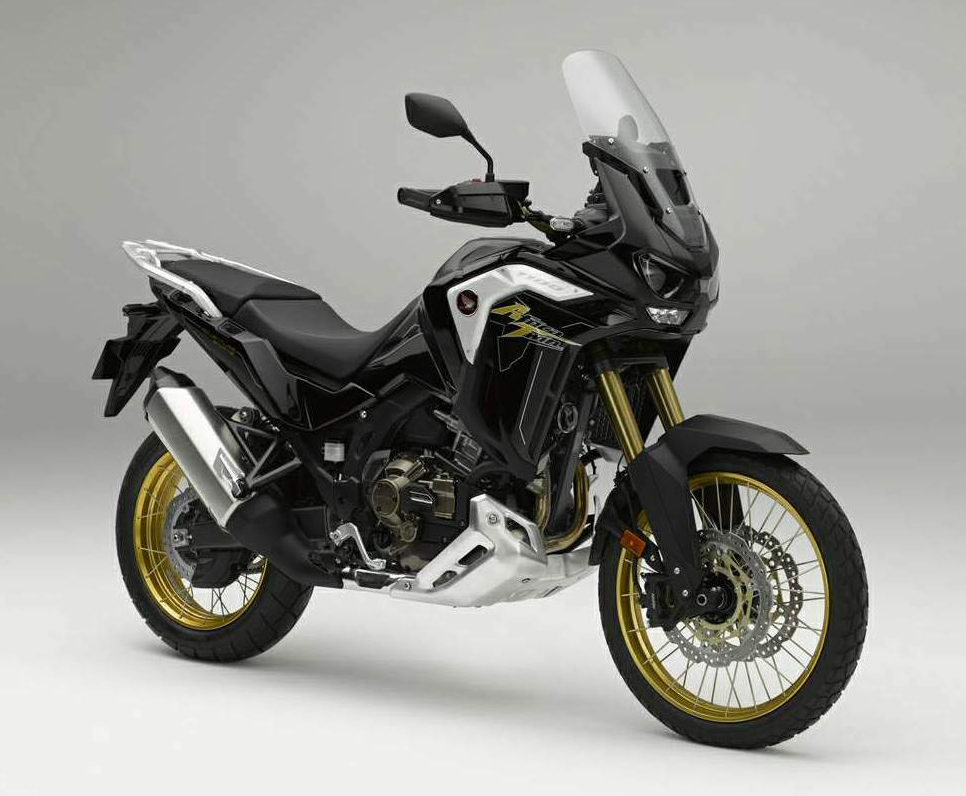
The appearance of the Adventure Sports ES version can be described as dignified but tough, with a 6.5 gallon tank for maximum range, an expanded front fairing that offers ample wind and weather protection, a substantial aluminum skid plate and an aluminum rear rack. To adapt to varying body types and riding conditions, the Adventure Sports ES version has a screen that is adjustable with no tools, between five positions, and it's higher than that of the standard type (165 mm higher in the low position, 225 mm higher when in the high position). The Adventure Sports ES has tubeless tires, and its seat height is the same as on the standard version. Heated grips and an accessory charger are standard. The Adventure Sports ES comes in a new Darkness Black Metallic color.
Both iterations of the Africa Twin share the same handlebar height, and the handlebar bend delivers a comfortable riding stance whether seated or standing. The seat height is adjustable between two positions: 34.3 inches and 33.6 inches. (To allow even more adjustment, higher and lower seats are available as accessories.) Ground clearance is 9.8 inches.
Curb weight for the Adventure Sports ES is 530 pounds with a full tank of fuel, while the standard version weighs 501 pounds. In both cases, DCT adds 23 pounds.
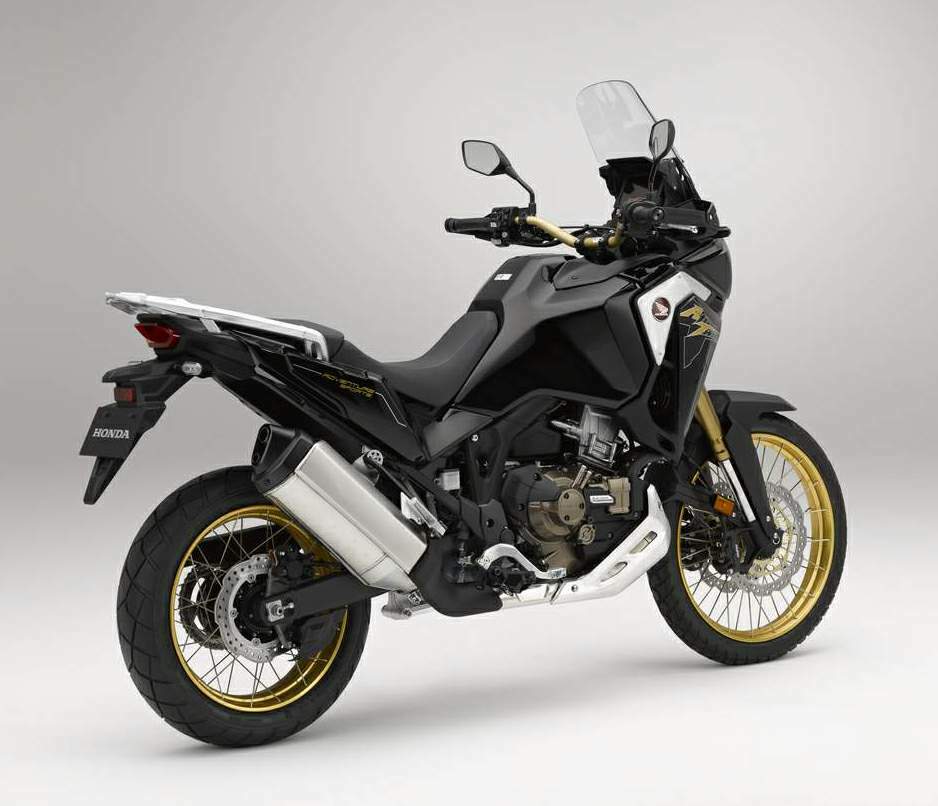
ELECTRONIC TECHNOLOGY
Throttle-by-wire is used on the Africa Twin, featuring a Bosch MM7.10 IMU that performs real-time six-axis measurement (angle and rate for roll, pitch and yaw) to identify the motorcycle's position and movement. This maximizes the accuracy of various controls and systems, including shifting, Honda Selectable Torque Control (HSTC), suspension, braking and lighting.
A bright 6.5 inch thin film transistor (TFT) LCD touch panel simplifies viewing, understanding and managing a plethora of data while concentrating on riding. Users can select from three screen-display arrangements and background colors, depending on personal preference.
The meter is compatible with Apple CarPlay® and can be connected to smartphones or headsets via Bluetooth. (Check state laws for legality.) By connecting an Apple iPhone via a USB cable, riders and passengers can issue voice-control commands via a headset microphone in order to use the phone or apps like Music, Maps and social networks, as well as Apple authentication.
The Adventure Sports ES version also has three-stage cornering lighting for optimal illumination depending on the corner type. Interpreting information from the IMU to determine the motorcycle's lean angle, the system provides auxiliary illumination from a pair of lights below the headlights; the greater the lean angle, the more light is spread toward the inside of the corner. Cruise control is standard on both versions.

ENGINE / DRIVETRAIN
The Africa Twin has a water-cooled, single-overhead cam, eight-valve, parallel-twin engine configuration, and for good touring capability, displacement is 1,084cc, achieved via 92.0 and 81.5 mm bore and stroke figures. The cylinder sleeves are aluminum, helping to minimize weight. The 270° phased crankshaft and uneven firing interval create the engine's distinctive throb and feel for rear-wheel traction. The 46 mm throttle body's injector angle delivers a direct spray into the twin-spark combustion chambers.
The crankcases are split vertically, and the water pump is housed within the clutch casing, with a thermostat integrated into the cylinder head. The water and oil pumps are driven by the engine's balancer shafts. These features contribute to the engine being compact and short, and to optimize ground clearance, a crucial element for off-road performance.
Honda's SOHC Unicam® valve train is a feature of the CRF450R motocrosser, and the low-set position of the cast camshaft contributes to the compact nature of the cylinder head. The engine uses a semi-dry sump and in-tank lower-crankcase oil storage, allowing a shallow pan depth and reducing overall engine height. As the pressure-fed pump is located within the oil tank, there is no need for a pressure-feed passage, again saving weight and space.
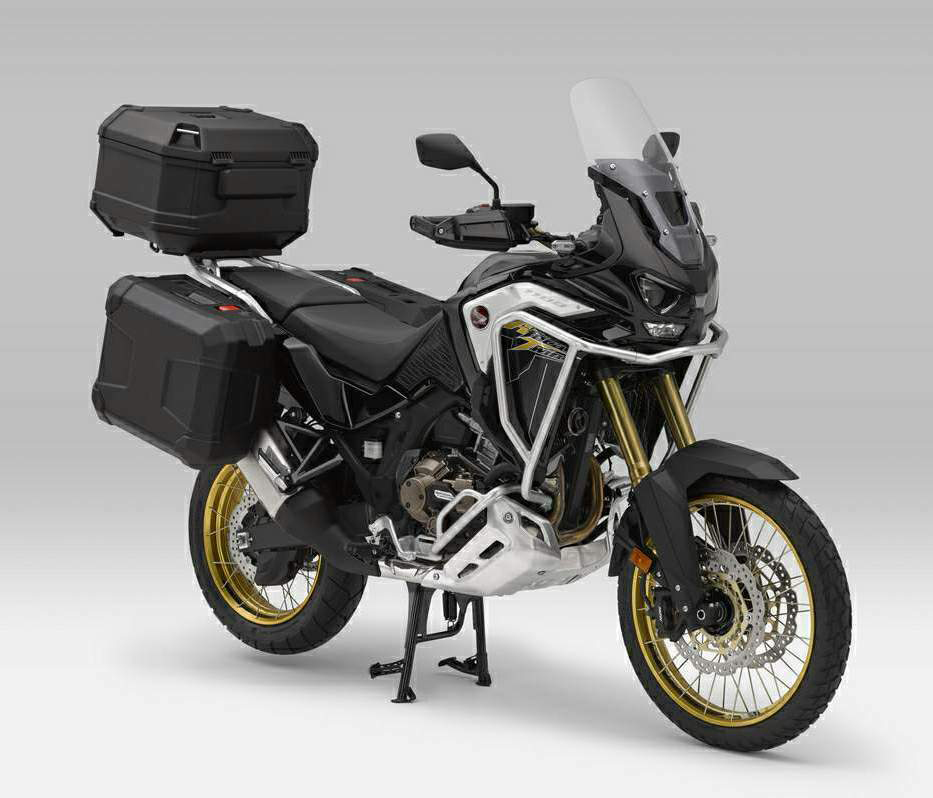
Exhaust System
The muffler features a single inlet and dual outlets, with an Exhaust Control
Valve (ECV)—similar to that on the CBR1000RR sport bike—located just downstream
of the split, in the main pipe. The exhaust valve closes off the larger pipe at
low rpm for a pulsating feel but opens at high rpm so that gases exit through
both pipes for improved output.
The dual catalytic converters are compact, which is possible because generation of a swirl-flow enables the exhaust gases to be evenly applied to those catalyzers' surfaces. The result is not only minimal power loss, but efficient exhaust-gas purification. The catalytic converters are positioned close to the center of gravity, contributing to good handling feel through the centralization of mass.
Lean-air/fuel sensors (LAF) positioned in the single muffler, at the upstream end of both exhaust pipes, constantly monitor the combustion status of each cylinder and apply appropriate fine-combustion control, thereby achieving excellent emission performance.
Transmission
In the world of powersports, Honda is a pioneer with DCT, having first offered
it on the 2009 VRF1200. The 2016 reintroduction of the Africa Twin welcomed DCT
to the adventure category, and it was well-received, thanks in part to the fact
that it enables riders to focus attention on line selection and throttle control
during off-road going, without concern of stalling. Globally, approximately half
of Africa Twin customers choose DCT versions.
DCT delivers consistent, rapid, seamless gear changes, and very quickly becomes second nature to use. It utilizes two clutches—one for startup and first, third and fifth gears, the other for second, fourth and sixth, with the main shaft for one clutch located inside that of the other. Each clutch is independently controlled by its own electro-hydraulic circuit. When a gear change occurs, the system pre-selects the target gear through the clutch not currently in use. The first clutch is then electronically disengaged as the second clutch simultaneously engages. As the twin clutches transfer drive from one gear to the next with minimal interruption to rear-wheel drive, gear-change shock and pitching of the machine are minimized, resulting in shifts that are not only smooth, but direct. The extra benefits of durability (as the gears cannot be damaged by missing a shift), low-stress urban riding and reduced rider fatigue add to the appeal of DCT.
On the Africa Twin, Honda's advanced automatic DCT technology benefits from the IMU, which allows cornering detection for optimized shift timing, and the algorithm smoothens acceleration from a dead stop.
With DCT on the Africa Twin, three modes of gear-change operation are available:
AT D (“Drive”): An automatic setting that is ideal for daily city and highway
riding, when comfort and optimum fuel efficiency are prioritized.
AT S (“Sport”): An automatic setting that is suited for sportier riding, as the
ECU lets the engine rev a little higher before shifting up, and shifts down
sooner when decelerating, for extra engine braking. There are three
memorize-able sub-settings within S mode, from the more “torquey,” moderately
sporty Level 1, to the sportiest Level 3.
MT (“Manual”): A setting that gives full manual control, allowing the rider to
change gears via handlebar triggers.
In the two automatic modes, immediate manual intervention is possible; the rider
simply selects the required gear using the up and down shift triggers on the
left side of the handlebar. After an appropriate interval (depending on throttle
angle, vehicle speed and gear position), the DCT seamlessly reverts back to
automatic mode.
A G-Switch enables the rider to select the riding feel, depending on factors like surface conditions. With the G-Switch turned off, the clutches are allowed to “slip” against engine torque, for a smooth reaction to throttle operation; benefits include increased assurance during situations like low-speed U-turns, for example, and mitigated fatigue during long-distance riding. On the other hand, turning on the G-Switch results in reduced clutch “slip,” allowing the rider to more readily slide the rear tire via throttle input, in order to maneuver the bike.
Further functionality for the DCT system comes in the form of incline detection, adapting the gear-shift pattern depending on the grade of an incline.
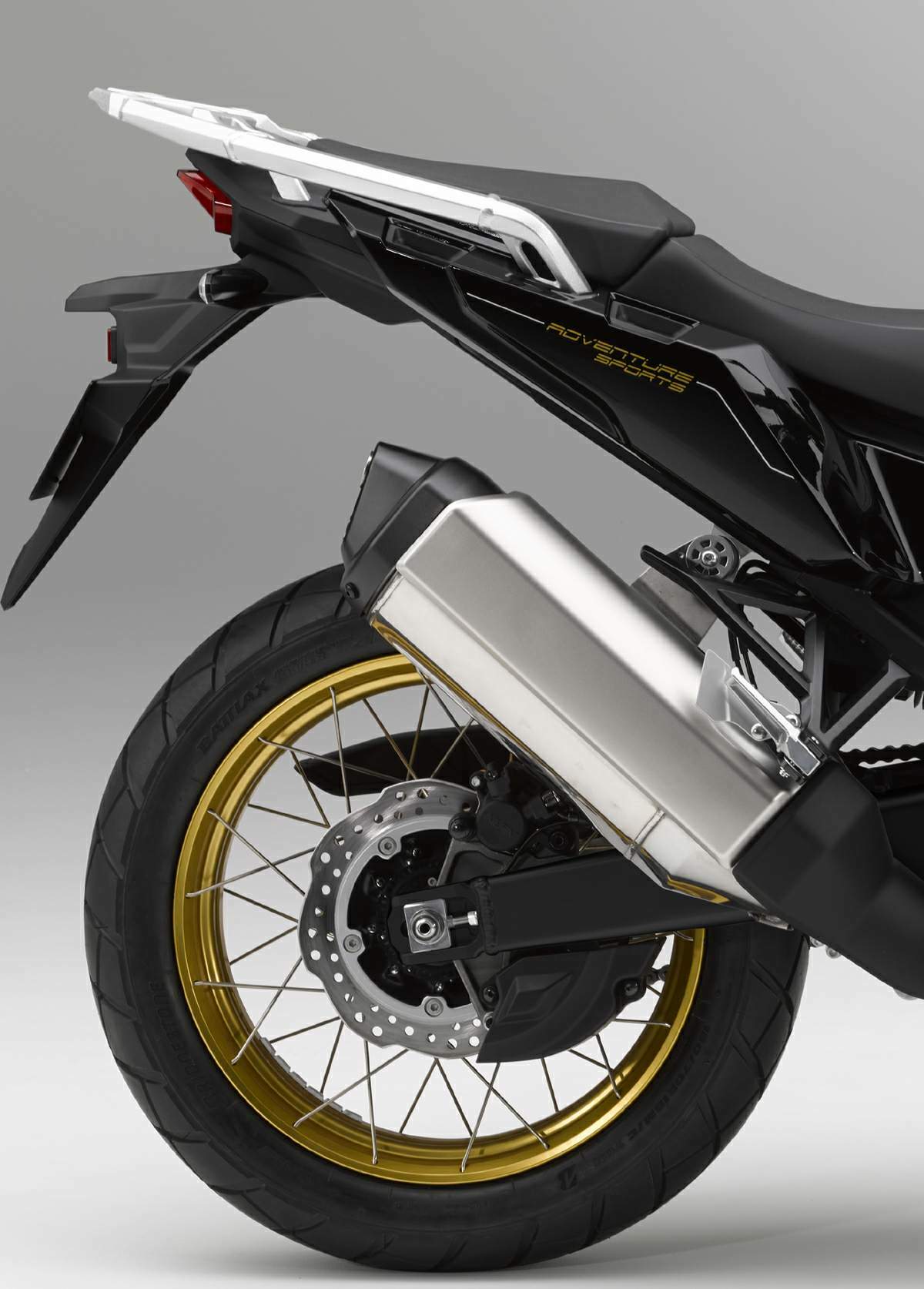
Manual-transmission versions of the Africa Twin are offered for customers who still enjoy making gear selections themselves. The six-speed manual gearbox uses the same shift-cam design as found on the CRF450R to ensure positive gear changes. The aluminum clutch center and pressure plate use “assist” cams to ease shifting (with light lever feel) and “slipper” cams for deceleration and downshifting.
An accessory quick shifter is available to eliminate the need to use the clutch or close the throttle during gear changes. When the shift pedal is operated, the shift rod's stroke sensor converts that movement into electronic signals, and the system considers ECU information such as vehicle speed, engine acceleration, deceleration condition and gear position in order to determine timing of the fuel-injection interruption, the throttle-valve opening and the ignition timing, thereby lowering the drive load on the transmission gear for shifting.
HSTC
The Africa Twin's Honda Selectable Torque Control utilizes the IMU, enabling
smooth slide control and wheelie control, assisting riders of widely ranging
skill levels by maximizing acceleration performance.
With HSTC, the ECU uses data from sensors on the front and rear wheels to identify different situations. When the rear wheel accelerates suddenly but the front wheel doesn't, the system concludes that rear-tire spin is occurring. To rectify the situation, engine torque is reduced based on the amount of slip, the slip change rate, and the motorcycle's rolling and yawing behavior, helping to correct the slide. Riders can select from seven levels of slip control that cover a broad range, with Level 1 intervening less and Level 7 intervening more. Slip-control intervention can be switched off, and three levels of engine braking are available.
When the system detects the rear wheel accelerating while the front wheel decelerates, a wheelie is the diagnosis, so engine torque is reduced based on the motorcycle's pitch angle, helping to bring the front wheel back down. There are three levels of wheelie control, with Level 1 allowing intentional front-wheel lift and Level 3 making it much harder to wheelie. As with slide control, wheelie control can be switched off.
Note that HSTC does not eliminate the possibility of slides or wheelies; rather, it is an auxiliary system to assist the rider during acceleration operations. As is the case with models without HSTC, the Africa Twin will not handle unreasonable operations.
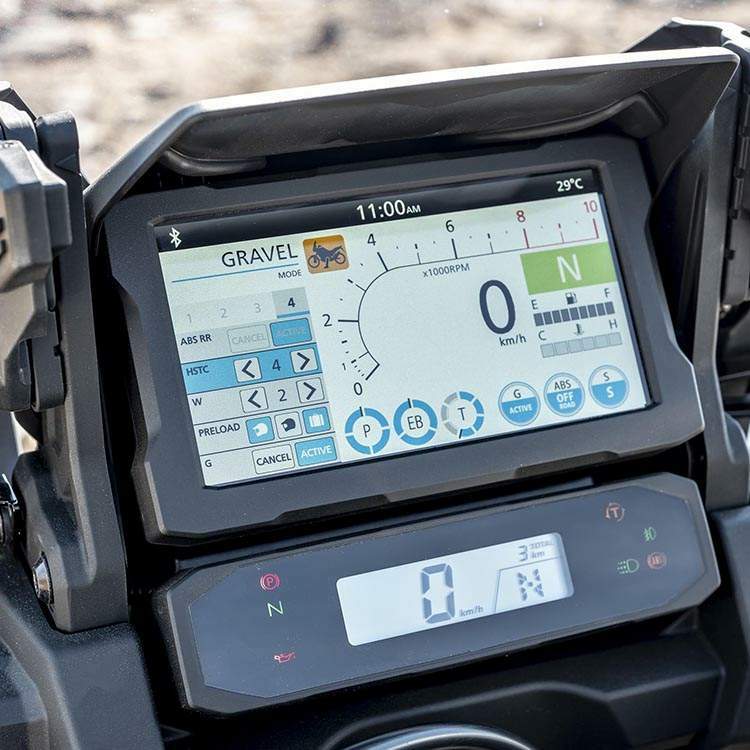
Riding Modes
Riders can change between six riding modes, each of which respond to a wide
variety of situations, providing a sense of assurance and enhancing enjoyment.
The modes are:
TOUR: A preset mode assuming long-distance riding with luggage, giving
powerful acceleration.
URBAN: A preset mode dealing with a wide variety of riding needs.
GRAVEL: A preset mode for comfortable riding on poor surface conditions,
suitable for riding on flat dirt roads.
OFF-ROAD: A preset mode for riding on unpaved surfaces.
USER 1: A customize-able mode that a rider can set to his or her preference.
USER 2: An alternative customize-able mode that the rider can set.
Each riding mode adjusts power output; level of engine braking; suspension
damping (hard/standard/soft); front ABS (on-road/off-road); and rear ABS
(active/inactive). In the two USER modes, the owner can fine-tune the settings
within each of those areas; many may choose to set up USER 1 mode with their
favorite on-road settings and USER 2 with their preferred off-road settings.
Screen color can also be customized for each of the six modes.
HSTC is not linked to riding modes.
Battery
A lightweight, compact ELIIY Power lithium-ion battery helps minimize weight and
centralize mass. This battery has minimal self-discharge, and Honda tests showed
it to offer greater longevity than a comparable lead-acid unit, both in terms of
life and the ability to retain a charge.
CHASSIS
Frame
The Africa Twin uses a steel semi-double-cradle frame, with optimized
rigidity/flex characteristics for challenging situations like riding with
luggage, riding two-up, or off-road riding. For example, rigidity around the
steering head has been optimized to enhance front-end feel and grip, and the
main spars are optimized to enhance longitudinal rigidity for good handling
under braking. The frame's pivot plates are 600MPa high-strength steel. The rear
cross pipe, which connects the left and right pivot plates in the upper area, is
located in line with the shock stroke, resulting in a direct transmittal of
surface information to the frame for good rear-wheel feel.
In addition, the rear subframe is separate and constructed of aluminum, minimizing weight while retaining the ability to carry luggage. The seat rails are narrow at the front, maximizing ease of movement during stand-up riding and allowing the rider's legs to reach the ground more easily when stopped.

Suspension
Intelligent, electronic suspension is offered on the Adventure Sports ES version
of the Africa twin, in the form of Showa's EERA. The system provides excellent
response to immediately optimize damping force based on the suspension stroke
speed at riding and the vehicle's running condition, and aims to achieve
high-level suspension characteristics required for disparate situations often
encountered on adventure rides.
With EERA, five suspension modes are available, each with different preload and damping settings:
HARD: A preset mode with high damping forces for both high and low
suspension-stroke speeds—achieving ride stability suitable even for riding
two-up with luggage.
MID: A preset mode with intermediate damping forces, between HARD and
SOFT—suitable in a wide variety of circumstances.
SOFT: A preset mode with soft damping characteristics for both high and low
suspension-stroke speeds—achieving ride comfort and stability even on rough
terrain.
OFF-ROAD: A preset mode with progressive front-suspension characteristics, with
damping force rising gradually between low and high stroke speed;
rear-suspension characteristics with damping force that is between SOFT and MID.
USER: A customize-able mode that allows fine damping adjustments front and rear,
along with 24 points of rear-spring preload, to meet rider preference.
The first four suspension modes are linked to the various riding modes, whereas USER riding mode allows custom adjustment of the USER suspension mode.
Front and rear suspension on the standard version of the Africa Twin are also fully adjustable including preload, compression damping and rebound damping, with tuning changes accomplished via traditional dials and knobs.
Regarding suspension hardware, both Africa Twin versions feature a 45mm cartridge-type inverted Showa fork with a most-in-class 9.1 inches of travel, and settings deliver on-road comfort and off-road performance. The top triple clamp is cast aluminum, while the bottom is forged.
The Pro-Link® rear-suspension system offers 9.4 inches of travel, and the shock is centered. A spherical, solid pillow ball mount is used at the top of the shock to minimize deflection and help achieve a precise feel in varying conditions. The aluminum swingarm, based on that of the CRF450R motocrosser, is extremely rigid despite being quite light. The Africa Twin has 9.8 inches of ground clearance for excellent off-road performance.
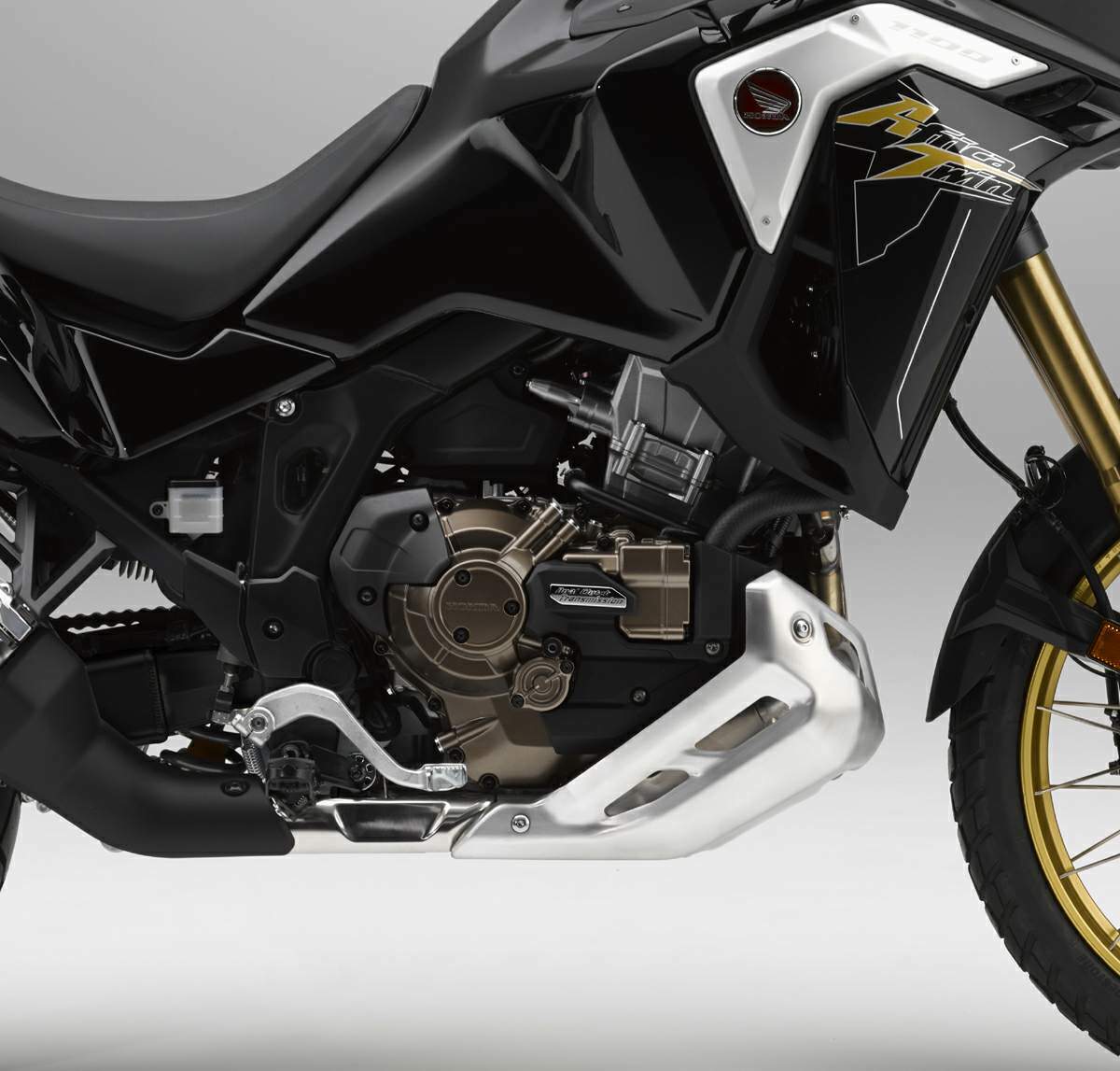
Brakes
The Africa Twin has ABS, and advanced technologies enhance braking performance
and rider confidence in varying conditions. Separate modes for on-road and
off-road work together with the riding modes, allowing application-specific
braking performance.
In addition, the system can adapt during trail braking: When the IMU detects a lean angle (indicating that a cornering maneuver is being executed), and the wheel sensors detect deceleration (indicating that the rider is braking), the system closely monitors both wheels' slip rates and makes necessary adjustments in braking pressure. During sudden braking, ABS reads IMU information to detect rear-wheel lift and precisely controls braking pressure to suppress that trend for improved control and confidence.
Note that ABS is an auxiliary system to assist the rider for braking operations. As is the case with standard braking systems, ABS requires adequate deceleration before corners, for example.
The Africa Twin's rear ABS can be switched off when the rider prefers separate front and rear braking performance, for example in order to brake-slide the rear wheel for off-road cornering.
As for braking hardware, compact two-piece, radial-mount, four-piston calipers work dual 310 mm petal-style floating rotors through sintered pads and serve up consistent stopping power and feel on-road or off. The rear rotor has a diameter of 256 mm and also features a petal design.
HONDA ACCESSORIES
A full range of genuine Honda accessories is available for both versions of the Africa Twin, including aluminum luggage, higher and lower seats, a DCT foot-shift pedal, a center stand, a tank bag and more.
|
Any corrections or more information on these motorcycles will be kindly appreciated. |